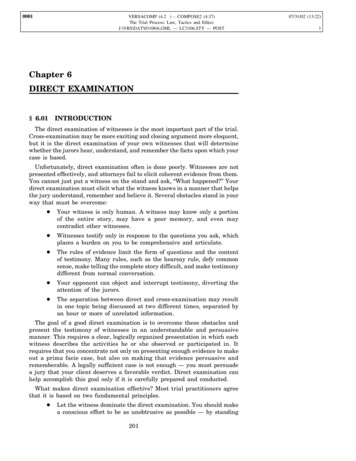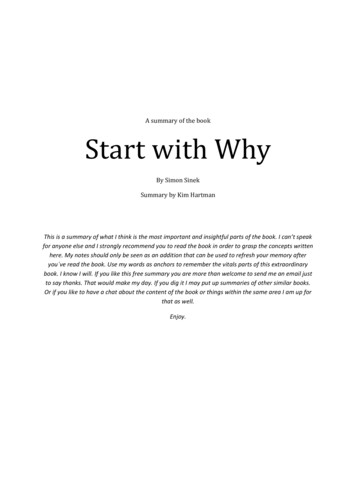
Transcription
A summary of the bookStart with WhyBy Simon SinekSummary by Kim HartmanThis is a summary of what I think is the most important and insightful parts of the book. I can’t speakfor anyone else and I strongly recommend you to read the book in order to grasp the concepts writtenhere. My notes should only be seen as an addition that can be used to refresh your memory afteryou ve read the book. Use my words as anchors to remember the vitals parts of this extraordinarybook. I know I will. If you like this free summary you are more than welcome to send me an email justto say thanks. That would make my day. If you dig it I may put up summaries of other similar books.Or if you like to have a chat about the content of the book or things within the same area I am up forthat as well.Enjoy.
ction: why start with why? . 3Chapter 1: Assume you know . 3Chapter 2: Carrots and sticks . 4Manipulation vs. inspiration. 4Price . 4Fear . 4Peer pressure . 4Novelty . 4The price you pay for the money you make. 4Manipulations lead to transactions, not loyalty . 5Chapter 3: The golden circle. 5Chapter 4: This is not opinion. This is biology . 6Gut decisions don’t happen in your stomach . 6It’s what you can’t see that matters . 7Chapter 5: Clarity, discipline and consistency . 7Discipline of HOW. 7Consistency of WHAT . 7If you don’t know why, you can’t know how . 7Three degrees of certainty . 8Chapter 6: The emergence of trust . 8The only difference between you and a caveman is the car you drive. 9Finding the people who believes what you believe . 9Innovation happens a the edges . 10The definition of trust . 10The influence of others . 11Chapter 7: How a tipping point tips . 11Refusing to consider the law of diffusion will cost you . 12Chapter 8: Start with why, but know how . 13The chosen path . 13I have a dream . 13Those who know WHY need those who know HOW . 13Build a megaphone that works . 14Say it only if you believe it . 141
howdy@kimhartman.sewww.kimhartman.seChapter 9: Know why. Know how. Then what? . 14Chapter 10: Communication is not about speaking, it’s about listening . 15Chapter 11: When why goes fuzzy . 15Achievement vs. success . 15Chapter 12: Split happens . 15Chapter 13: The origins of a WHY . 16Chapter 14: the new competition . 162
howdy@kimhartman.sewww.kimhartman.se“The more organizations and people who learn to start with WHY, the more people there will be whowake up being fulfilled by the work they do.”Introduction: why start with why?The ability to motivate people is, in itself, not difficult. It is usually tied to some external factor. Greatleaders, in contrast are able to inspire people to act. Those who are able to inspire give people asense of purpose or belonging that has little to do with any external incentive or benefit to begained. Those who truly lead are able to create a following of people who act not because they wereswayed, but because they were inspired.For those who are inspired, the motivation to act is deeply personal. They are less likely to be swayedby incentives. Those who are inspired are willing to pay a premium or endure inconvenience, evenpersonal suffering. Those who are able to inspire will create a following of people – supporters,voters, customers, workers – who act for the good of the whole not because they have to, butbecause they want to.People who love going to work are more productive and creative. They go home happier and havehappier families. They treat their colleagues and clients and customers better. Inspired employeesmake for stronger companies and stronger economies.Chapter 1: Assume you knowWe make assumptions about the world around us based on sometimes incomplete or falseinformation – we make decisions based on what we think we know. Do we really know why someorganizations succeed and why others don t, or do we just assume?If things don’t go as expected, it’s probably because we’ve missed one. More data, however, doesn’talways help. There are other factors that must be considered, factors that exist outside of ourrational, analytical, information-hungry brains.Example – the Japanese automakerAn American executive went to see a Japanese car assembly line. At the end of the line, the doorswere put on the hinges, the same as in America. But one step was missing in Japan. In America,workers would take rubber mallets and tap the edges of the door to ensure that it fit perfectly.”We make sure it fits when we design it”.The Japanese didn’t examine the problem and accumulate data to figure out the best solution – theyengineered the outcome they wanted from the beginning. If they didn’t achieve their desiredoutcome, they understood it was because of a decision they made at the start of the process. Whatthe American automakers did with their rubber mallets is a metaphor for how many people andorganizations lead.3
howdy@kimhartman.sewww.kimhartman.seThere are those who decide to manipulate the door to fit to achieve the desired result and there arethose who start from somewhere very different. Though both courses of action may yield similarshort-term results, it is what we can’t see that makes long-term success more predictable for onlyone. The one that understood why the doors need to fit by design and not by default.Chapter 2: Carrots and sticksManipulation vs. inspirationThere are only two ways of influence human behavior: you can manipulate it or you can inspire it.Typical manipulations include dropping the price, running a promotion, using fear, peer pressure etc.when companies do not have a clear sense of why their customers are their customers, they tend torely on a disproponiate number of manipulations to get what they need.PriceFor the seller, selling based on price is like heroin. The short-term gain is fantastic, but the more youdo it, the harder it becomes to kick the habit. Once buyers get used to paying a lower-than-averageprice for a product or service, it is very hard to get them to pay more.FearFear, real or perceived, is arguably the most powerful manipulation.Peer pressureWhen marketers report that a majority of a population or a group of experts prefers their productover another, they are attempting to sway the buyer to believing that whatever they are selling isbetter. Peer pressure works not because the majority or the experts are always right, but because wefear that we may be wrong.NoveltyReal innovation changes the course of industries or even societies, like the light bulb, the microwaveand iTunes. Adding a camera to a mobile phone is not an innovation – a great feature, but notindustry altering.Novelty can drive sales but the impact does not last. If a company adds too many novel ideas toooften, it can have a similar impact on the product or category as the price game. In an attempt todifferentiate with more features, the product start to look and feel more like commodities and, likeprice, the need to add yet another product to the line of compensate for the commodization ends ina downward spiral.The price you pay for the money you makeManipulations don’t breed loyalty, although they can drive sales. Over time, they cost more andmore. And they increase the stress for both buyer and seller.4
howdy@kimhartman.sewww.kimhartman.seRepeat business is when people do business with you multiple times. Loyalty is when people arewilling to turn down a better product or better price to continue doing business with you. Loyalcustomers often don t even bother to research the competition.Addicted to the short term results, business today has largely become a series of quick fixes added onone after another.Manipulations lead to transactions, not loyaltyFor transactions that occur an average of once, carrots and sticks are the best way to elicit thedesired behavior. Manipulations are perfectly valid strategy for driving a transaction.It is the feeling of “we re in this together” shared between customer and company that defines greatleaders.Chapter 3: The golden circleThe golden circle finds order and predictability in human behavior. Put simply, it helps us understandwhy we do what we do.WHAT: every single company on the planet knows what they do.HOW: are often given to explain how something is different or better, like USP or value proposition.WHY: very few people can clearly articulate why they do what they do – what is your purpose, causeor belief? When most companies and people think, act or communicate they do so from the outsidein, from WHAT to WHY.Apple if they were like everyone else:We make great computers. They are beautiful designed, simple to use and user-friendly. Want to buyone?How Apple actually communicate:Everything we do, we believe in challenging the status quo. We believe in thinking differently. Theway we challenge the status quo is by making our products beautifully designed, simple to use anduser-friendly. And we happen to make great computers. Want to buy one?Apple simply doesn’t reverse the order of information, their message starts with WHY, a purpose,cause or belief that has nothing to do with WHAT they do. What they do – the products that theymake, from computers to small electronics – no longer serves as the reason to buy, they serve as thetangible proof of their cause. People don’t buy what you do, they buy why you do it.Organizations use the tangible features and benefits to build a rational argument for why theircompany, product or idea is better than another. Companies try to sell us WHAT they do, but we buyWHY they do it. When communicating from the inside and out, the WHY is offered as the reason tobuy and the WHAT serve as the tangible proof of that belief.5
howdy@kimhartman.sewww.kimhartman.seConsumers and investor are completely at ease with Apple offering so many different products in somany categories. It’s not WHAT Apple does that distinguishes them. It is WHY they do it. Theirproducts give life to their cause and everything they do works to demonstrate their WHY.Apples competitors lost their cause, they turned from companies with a cause into a company thatsold products. And when that happens, price, quality, service and features become the primarycurrency to motivate a purchase decision. At that point a company and its products have becomecommodities.A company doesn’t have to have the best product, they just need to be good or very good. Better orbest is a relative comparison. Without first understanding of WHY, the comparison itself is of novalue on the decision maker.Macs are, in practice, only better for those who believe what Apples believe. Those people whoshare Apple s WHY believe they their products are objectively better.If a customer feels inspired rather than manipulated to buy a product, they will be able to verbalizethe reasons why they think what they bought is better.It is the cause that is represented by the company, brand, product or person that inspires loyalty.Instead of asking “WHAT should we do to compete?” the questions must be asked, “WHY did westart doing WHAT we re doing in the first place, and WHAT can we do to bring our cause to lifeconsidering all the technologies and market opportunities available today?”Chapter 4: This is not opinion. This is biologyOur need to belong is not rational, but it is a constant that exists across all people in all cultures. It isa feeling we get when those around us share our values and beliefs. When we feel like we belong wefeel connected and we feel safe. As humans we crave the feeling and we seek it out. No matterwhere we go, we trust those with whom we are able to perceive common values or beliefs.We want to be around people and companies who are like us and share our beliefs. When a companyclearly communicates their WHY and we believe what they believe, then we will sometimes go toextraordinary lengths to include those products or brands in our lives. This is not because they arebetter, but because markers or symbols of the values and beliefs we hold dear.We are drawn to leaders and organizations that are good at communicating what they believe.Gut decisions don’t happen in your stomachWhen a decision feels right, we have a hard time explaining why we did what we did. Decisionmaking and the ability to explain those decisions exist in different parts of the brain. This is thefamous gut decision, and it happens in the limbic brain. The reason gut decisions feel right is becausethe limbic brain also controls our feelings. His limbic brain is smart and often knows the right thing todo. It is our inability to verbalize the reasons that may cause us to doubt ourselves or trust theempirical evidence when our gut tells us not to.6
howdy@kimhartman.sewww.kimhartman.seHenry Ford: if I had asked people what they wanted, they would have said a faster horse. This is thegenius of great leadership. Great leaders and organizations are good at seeing what most of us can’tsee. They are good at giving us things we should never think of asking for.Great leaders are those who trust their gut. They are those who understand the art before sciencethey win hearts before minds. They are the ones who start with WHY.It’s what you can’t see that mattersProducts with a clear sense of WHY give people a way to tell the outside world who they are andwhat they believe. If a company does not have a clear sense of WHY then it is impossible for theoutside world to perceive anything more than WHAT the company does. And when that happens,manipulations that rely on price, features, service or quality become the primary currency ofdifferentiation.Chapter 5: Clarity, discipline and consistencyWhen manipulations thrive, uncertainty increases for buyers, instability increases for sellers andstress increases for all.Discipline of HOWHOW are your values or principles that guide how to bring your cause to life. HOW we do thingsmanifests in the systems and processes within an organization and the culture. For values orprinciples to be truly effective they have to be verbs. It’s not “integrity”, its “always do the rightthing”; not “innovation”, but “look at the problem from a different angle”. Articulating our values asverbs gives us a clear idea; we have a clear idea of how to act in any situation.Consistency of WHATEverything you say and everything you do have to prove what you believe. A WHY is just a belief.HOWs are the actions you take to realize that belief. And WHATs are the results of those actions –everything you say and do.With consistency people will see and hear, without a shadow of doubt, what you believe. The onlyway people will know what you believe is by things you say and do, and if you re not consistent in thethings you say and do, no one will know what you believe.What authenticity means is that your golden circle is in balance. It means that everything you say andeverything you do you actually believe. Only when that happens can the things you say and do beviewed as authentic. Being authentic is not a requirement for success, but it is if you want thatsuccess to be a lasting success. Authenticity is when you say and do the things you actually believe.Without a WHY, any attempt at authenticity will almost always be inauthentic.If you don’t know why, you can’t know howIt I a false assumption that differentiation happens in HOW and WHAT you do. Simply offering a highquality product with more features or better services or a better price does not create difference.Doing so guarantees no success. Differentiation happens in WHY and HOW you do it.7
howdy@kimhartman.sewww.kimhartman.seThere are many ways to motivate people to do things, but loyalty comes from the ability to inspirepeople. Only when the WHY is clear and when people believe what you believe can a truerelationship develop.Manipulations and inspiration are similar, but not the same.It is when that emotional feeling goes deeper than insecurity or dreams that the emotional reactionaligns with how we view ourselves. It is at that point that behavior moves from being motivated toinspired. When we are inspired, the decisions we make have more to do with who we are and less todo with the companies or products were buying.When our decisions feel right, we are willing to pay a premium or suffer an inconvenience for thoseproducts. Price, quality, features and service are important, but they are the cost of entry in businesstoday.Loyalty, real emotional value, exists in the brain of the buyer, not the seller.If your WHYs and their WHY correspond, then they will see your products and services as tangibleways to prove what they believe. When WHY, HOW & WHAT are in balance, authenticity is achievedand the buyer feels fulfilled. Without WHY, the buyer is easily motivated by aspiration or fear.The golden circle provides a way to communicate consistent with how individuals receiveinformation. For this reason and organization must be clear about its purpose, cause or belief andmake sure that everything they say and do is consistent with and authentic to that belief. If the levelsof the golden circle are in balance, all those who share the organizations view of the world will bedrawn to it and its products like a moth to a light bulb.Three degrees of certaintyWhen we can only point to tangible elements or rational measurements, the highest level ofconfidence we can give is: I think this is the right decision.When we make gut decisions, the highest level of confidence we can offer is: the decision feels right,even if it flies in the face of all the facts and figures.The ability to put a WHY into words provides the emotional context for decisions. When you knowyour WHY, the highest level of confidence you can offer is: I know its right. When you know thedecision is right, not only does it feel right, but you can also rationalize it and easily put it into words.The goal of business should not be to do business with anyone who simply wants what you have. Itshould be to focus on the people who believe what you believe.Chapter 6: The emergence of trustTrust is not a checklist. Fulfilling all your responsibilities does not create trust. Trust is a feeling, not arational experience.Trust begins to emerge when we have a sense that another person or organization is driven by otherthings than their own self-gain. With trust comes a sense of value – real value, not just value equatedwith money. Value, by definition, is the transference of trust. You have to earn trust by8
howdy@kimhartman.sewww.kimhartman.secommunicating and demonstrating that you share the same values and beliefs. You have to talkabout your WHY and prove it with WHAT you do. WHY is just a belief, HOWs are the actions we taketo realize that belief, and WHATs are the results of those actions. When all three are in balance, trustis built and value is perceived.Leading is not the same as being the leader. Being a leader means you hold the highest rank. Leading,however, means that others willingly follow you – not because they have to, not because they arepaid to, but because they want to.Those who trust work hard because they feel like they are working for something bigger thanthemselves.Beyond the structure and systems a company is nothing more than a collection of people.People live their life to win. The only variation is the score we use. For some its money, for others itsfame or awards.The drive to win is not, per se, a bad thing. Problems arise when the metrics become the onlymeasure of success, when what you achieve is no longer tied to WHY you set out to achieve it in thefirst place.The only difference between you and a caveman is the car you driveWe’ve succeeded as a species because of our ability to form cultures. Cultures are groups of peoplewho come together around a common set of values and beliefs. When we share values and beliefswith others, we form trust.We re friends with people who see the world the way we see it, who share our views and our beliefset.We do better in places that reflect our own values and beliefs. A company is a culture, a group ofpeople brought together around a common set of values and beliefs.The goal is not to hire people who simply have a skill set you need, the goal is to hire people whobelieves what you believe.Finding the people who believes what you believeWhen employees belong, they will guarantee your success. And they won’t be working hard andlooking for innovative solution for you, they will be doing it for themselves.The goal is to hire those who are passionate for your WHY, your purpose, cause or belief, and whohave the attitude that fits your culture. Once that is established, only then should their skill set andexperience be evaluated.Great companies do not hire skilled people and motivate them; they hire already motivated peopleand inspire them. People are either motivated or they are not. Unless you give motivated peoplesomething to believe in, something bigger than their job to work toward they will motivatethemselves to find a new job and you ll be stuck with whosever left.9
howdy@kimhartman.sewww.kimhartman.seCompanies with a strong sense of WHY are able to inspire their employees. Those employees aremore productive and innovative, and the feeling they bring to work attracts other people eager towork there as well.When people inside the company know WHY they come to work, people outside the company arevastly more likely to understand WHY the company is special.Innovation happens a the edgesPaying someone a lot of money and asking them to come up with great ideas ensures very little.However, pulling together a team of likeminded people and giving them a cause to pursue ensures agreater sense of teamwork and camaraderie.The role of a leader is not to come up with all the great ideas. The role of a leader is to create anenvironment in which great ideas can happen.Companies that define themselves by WHAT they do instead of WHY they do it instruct their peopleto be innovative around a product or service. “Make it better”, they are instructed. Those who workfor Apple s competitors, companies that have defined themselves as “computer manufacturers”,come to work to develop “more innovative” computers. The best they can do is add more RAM orsmall features that probably to will change the course of an industry.Apple does not have a lock on good ideas; there are smart, innovative thinkers at most companies.But great companies give their people a purpose or challenge around which to develop ideas ratherthan simply instruct them to make a better mousetrap.Companies with a clear sense of WHY tend to ignore their competition, whereas those with a fuzzysense of WHY are obsessed with what others are doing. People who come to work with a clear senseof WHY are less prone to giving up after a few failures because they understand the higher cause.Edison: “I didn’t find a way to make a light bulb, I found a thousand ways how not to make one”.The definition of trustOnly when individuals can trust the culture or organization will they take personal risks in order toadvance that culture or organization as a whole.Great organizations become great because the people inside the organization feel protected. Thestrong sense of culture creates a sense of belonging and acts like a net. People come to workknowing that their bosses, colleagues and the organization as a whole will look out for them. Thisresults in reciprocal behavior. Individual decisions, efforts and behavior that support, benefit andprotect the long-term interest of the organization as a whole.Only with mutual trust can an organization become great. Trust comes from being a part of a cultureor organization with a common set of values and beliefs. Trust is maintained when the values andbenefits are actively managed.An organization must work actively to remind everyone WHY the company exists. WHY it wasfounded in the first place. What it believes.10
howdy@kimhartman.sewww.kimhartman.sePassion comes from feeling like you are a part of something that you believe in, something biggerthan yourself.The influence of othersWe are more likely to trust those who share our values and beliefs. When we believe someone hasour best interest in mind because it is in their benefit to do so, the whole group benefits.Chapter 7: How a tipping point tipsIt’s the difference between a fad and an idea that changes an industry or society forever.Innovators pursue new products or ideas aggressively and are intrigued by any fundamental advance;being first is a central part of our lives.Although quick to see the potential and willing to take risks to try new technologies or ideas, earlyadopters are not idea generators like the innovators. But both groups are similar in that they relyheavily on their intuition. They trust their gut. Early adopters, like innovators but to a lesser degree,are willing to pay a premium or suffer some level of inconvenience to own a product or espouse anidea that feels right. Their willingness to suffer an inconvenience or pay a premium had less to dowith how great the product was and more to do with their own sense of who they are. They wantedto be first.The early and late majority are more practical-minded. For them, rational factors matter more. Thefarther right you go on the curve, the more you will encounter the clients and customers who mayneed what you have, but don’t necessarily believe what you believe. Everything usually boils down toprice with them. They are rarely loyal and they rarely give referral.It’s near impossible to achieve if you point your marketing and resources to the middle of the bell.This is because the early majority will not try something until someone else has tried it.Loyalty is when people are willing to suffer some inconvenience or pay a premium do business withyou.The goal of a business should not be to simply sell to anyone who wants what
A summary of the book . Start with Why . By Simon Sinek . Summary by Kim Hartman . This is a summary of what I think is the most important and insightful parts of the book. I can’t speak for anyone else and I stro
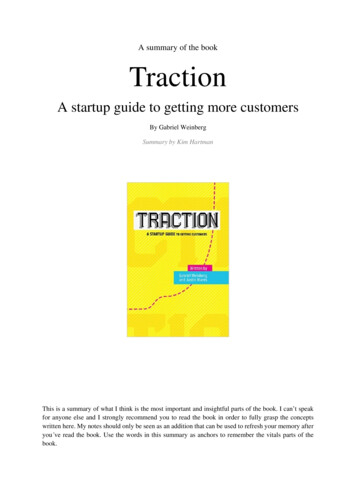
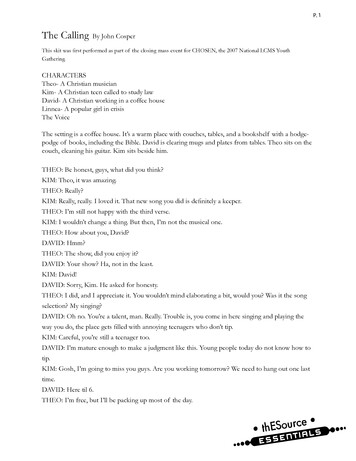

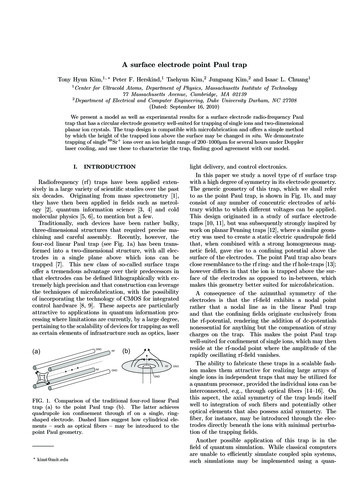

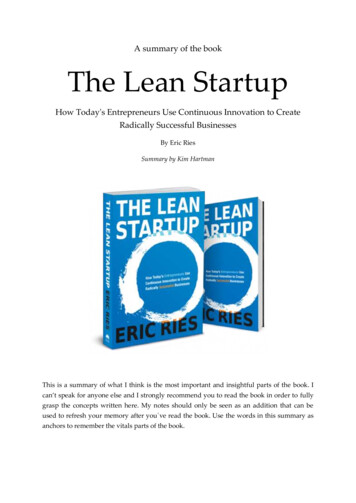
![[Page 1 – front cover] [Show cover CLEAN GET- AWAY 978-1 .](/img/13/9781984892973-6648.jpg)


